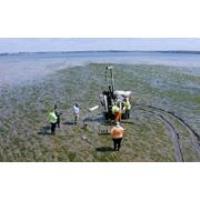
Research from the Portalis pilot project shows Mesolithic people settled on higher terrains, such as Creaden Head, due to rising sea levels, with evidence discovered of their occupation on the surviving high ground and on lower terrain that is currently submerged by rising seas. Research also indicates that Mesolithic peoples may also have occupied terrain tens of kilometres east of the present shoreline at Creaden Head.
Late Mesolithic and Late Neolithic activity has also been established at an excavation site at Llanllyr in Wales. There are potential signals in the pollen record that point to progressively more significant human impacts on landscapes with time from the Mesolithic through the post Roman period.
The exciting findings were presented by Portalis public archaeology team members Dr Joseph Schuldenrein and Prof Martin Bates at the project’s closure event ‘Ambition, Delivery & Future’ at the Granville Hotel, Waterford on Thursday 13 July.
For 15 months, researchers from Ireland and Wales have been working with six coastal communities to explore the earliest connections between both countries dating back to 10,000 years ago. The Mesolithic landscape was different than that of today because the coastline was tens of kilometres further east, and the sea level six to eight meters lower. Over time the sea level advanced landward and rates of sea level rise slowed. Over the course of the Bronze and Iron Ages the shoreline had migrated to the location of present day Fornaught Strand at Creaden Head. Current wave action erodes the sands of the existing beach and exposes evidence of a society that began to organise in groups, leaving remnants of structures and activity areas which the Portalis project team has uncovered.
Speaking at the closure event, Marc Ó Cathasaigh, Green Party T.D. and Spokesperson on Social Protection, said “The Portalis Project calls to mind the deep social and historical ties that bind us across the Irish Sea stretching back into pre-history. It reminds us of a time when our seas and rivers weren’t barriers but highways, facilitating trade and transfer of knowledge, skills and ideas between our shores right back to the Neolithic. The community engagement and citizen science elements of the Portalis project allows us to participate together in deepening our shared understanding and appreciation of the ties that have bound us for so long.”
The Portalis transdisciplinary pilot project owes its origin to the late citizen archaeologist Noel McDonagh, the key experts McDonagh engaged with, notably Prof Peter Woodman and Prof Stanton Green, the subsequent voluntary work of the Creadan Waterford Estuary Steering Group and the great support of its local coastal communities.
With the upcoming new series of citizen workshops in Ireland this summer and the launch in late July of the Portalis legacy visitor experiences at Waterford Treasures Museums and Ceredigion Museum, there is now a wide range of sustainable tourism initiatives, supporting sustainable green and blue economy growth, happening in both Ireland and Wales.
“Our findings provide new resources for our six coastal communities and their visitors. The pilot has delivered the first steps in underpinning sustainable new blue and green economy growth. Telling the story of our uniquely significant new data has and will help raise awareness of and interest in protecting our coastal cultural and natural heritage in the challenging times ahead,” said Joy Rooney, Portalis Senior Responsible Officer and Design Lead, Lecturer and Researcher in Design, South East Technological University (SETU).
Speaking of its significance, Dr Geraldine Canny, SETU Head of Research, added “I would like to congratulate all researchers and collaborators on the Portalis project which has generated valuable knowledge and outputs as well as increasing public awareness around public archaeology, conservation and citizen science. Hopefully this important work can continue."
The Portalis project, €1.95m, is supported with €1.5m funding from the European Regional Development Fund through the Ireland Wales Cooperation Programme, www.irelandwales.eu The project is led by South East Technological University, and is supported by the University of Wales Trinity Saint David, Ceredigion County Council and Waterford Chamber of Commerce.



